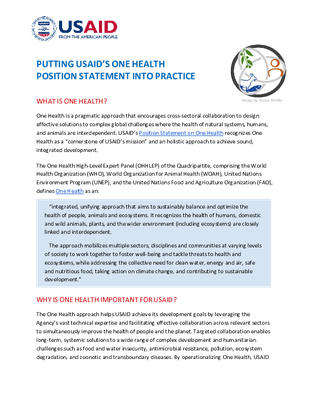Putting USAID's One Health Position Statement into Practice

One Health is a pragmatic approach that encourages cross-sectoral collaboration to design effective solutions to complex global challenges where the health of natural systems, humans, and animals are interdependent. USAID’s Position Statement on One Health recognizes One Health as a “cornerstone of USAID’s mission” and an holistic approach to achieve sound, integrated development.
WHY IS ONE HEALTH IMPORTANT FOR USAID?
The One Health approach helps USAID achieve its development goals by leveraging the Agency’s vast technical expertise and facilitating effective collaboration across relevant sectors to simultaneously improve the health of people and the planet. Targeted collaboration enables long-term, systemic solutions to a wide range of complex development and humanitarian challenges such as food and water insecurity, antimicrobial resistance, pollution, ecosystem degradation, and zoonotic and transboundary diseases. By operationalizing One Health, USAID aligns with global momentum to build holistic health capacity, while strengthening the Agency’s global One Health leadership. The collaborative, cross-sectoral and integrated core of the One Health approach aligns with USAID’s Policy Framework, the Sustainable Development Goals, Global Health Security Strategy, USAID Climate Strategy, and USAID Resilience Policy.
WHAT SHOULD BE THE GOAL OF A ONE HEALTH ACTIVITY?
In contrast to activities rooted in a single technical sector, One Health activities should strive to attain greater effectiveness and improved outcomes in multiple One Health sectors (human, animal, and ecosystem health). Technical experts should work together as cohesive One Health teams and strive to improve communication, collaboration and learning across relevant sectors. This approach improves synergies, leverages strengths and resources of cross-sectoral teams, and encourages innovative solutions to achieve long-lasting development and humanitarian outcomes.
WHAT ARE BEST PRACTICES FOR USAID ONE HEALTH PROGRAMMING?
The following recommendations build on USAID’s Position Statement on One Health and are intended to assist cross-sectoral teams with the design, implementation and monitoring of One Health activities to strengthen consistency, transparency and cross-sectoral outcomes. One Health programming should strive to include:
- Integrated design that simultaneously considers human, animal and ecosystem health perspectives to optimize collaboration while addressing a development or humanitarian issue, including shared technical, personnel and financial resources, where feasible.
- Explicit activity components for two or more One Health sectors* (human, animal, and/or ecosystem health).
- Systems thinking to understand the entire package of interrelated components and risks influencing a development or humanitarian issue and to optimize One Health sectoral linkages and co-benefits throughout design and implementation.
- Monitoring, evaluation and learning for relevant One Health technical sectors, which includes monitoring for indirect co-benefits and documenting evidence of cross-sectoral collaboration. [Note: USAID currently does not have standard indicators that explicitly capture the process of cross-sectoral collaboration; however, Measuring and Monitoring Multi-Sectoral Nutrition Collaboration provides many useful examples of custom indicators.]
- A clear theory of change or integrated narrative that demonstrates the linkages and interdependencies across all relevant health sectors (human, animal, and ecosystem health). Please include the term One Health to assist with information sharing and knowledge management.
WHAT ARE ADDITIONAL CONSIDERATIONS?
The following considerations support best practice in design and implementation of One Health activities:
- Engage relevant sectors early in co-creation of projects and activities.
- Systematically engage all stakeholders with an inclusive development lens in planning, implementation, monitoring, evaluation, and learning across the entire program cycle to ensure that the needs of all people are addressed across society.
- Elevate the traditional knowledge, practices and ideas of local actors as leaders in designing and implementing holistic solutions to development problems.
- Partner with and enable Indigenous Peoples’ self reliance, and promote cross-sectoral development approaches that support their development priorities.
- Identify gender- and youth-informed practices to best engage and empower women and youth.
USEFUL RESOURCES
The One Health High-Level Expert Panel produced or informed the following resources to help cross-sectoral teams collectively better prevent, predict, detect, and respond to health threats, particularly zoonotic spillover:
- One Health theory of change
- One Health Joint Plan of Action (2022 - 2026)
- The guide to implementing the One Health Joint Plan of Action at national level
- Guidance on Selection and Use of One Health Operational Tools
- OHHLEP inventory of One Health tools and resources
- Prevention of zoonotic spillover: From relying on response to reducing the risk at source



